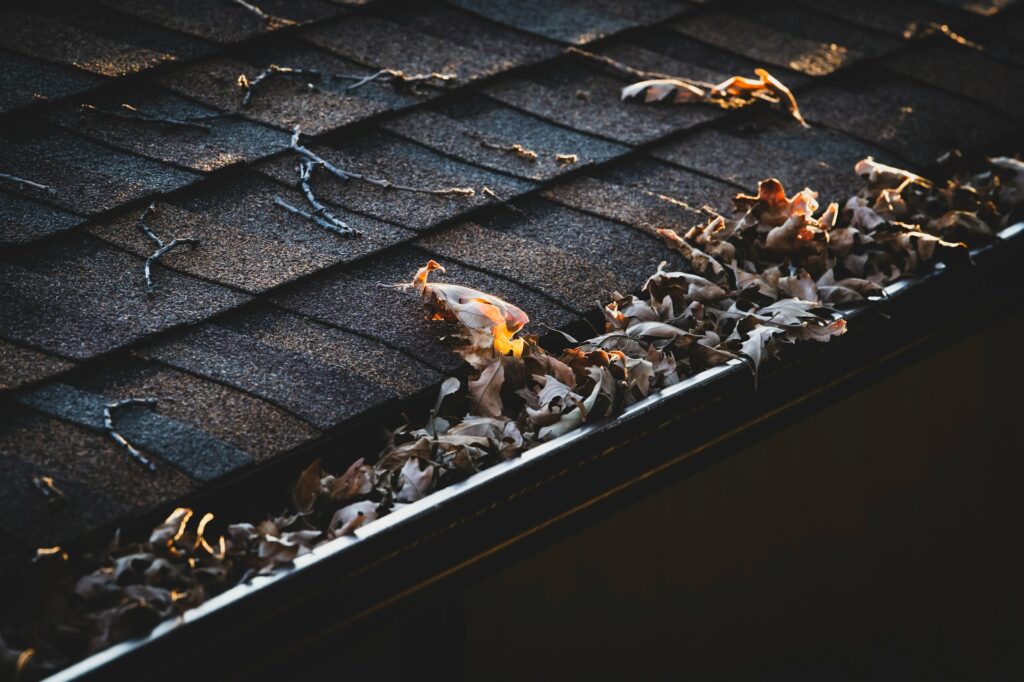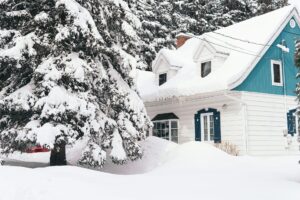Salem’s transition from summer’s last dry days to fall’s first heavy rains can happen quickly. While the region enjoys a generally mild climate, October often arrives with steady rainfall and gusty winds. These dramatic weather shifts test the resilience of Salem homes, particularly their roofs and gutter systems. The intensity of fall storms brings water, leaves, and debris that can strain vulnerable areas, forcing us to reevaluate the condition of shingles, flashing, gutters, and moss prevention measures.
Whether you’re a seasoned homeowner or new to Salem, planning for fall storms sets the stage for a safe, leak-free season. Proactive checks of your roof, gutter troughs, valleys, and downspouts come before emergency repairs and unexpected expenses. In this guide, we’ll explore why fall is the perfect time for roof inspections in Salem, how to strengthen your system against heavy rain and winds, and get your home ready for the season’s moisture challenges.
A Dramatic Seasonal Shift in Salem
From late summer to early fall, Salem experiences noticeable changes in temperature and precipitation. Warm, dry days can give way to sudden storms that deliver moisture-laden winds seemingly overnight. If your property enters this transitional period without proper preparation, roof leaks and gutter clogs become more likely.
• Rainfall in October: Historically, Salem sees a marked increase in rainfall in October. Even if the beginning of the month remains dry, it’s wise to prepare for a quick switch to heavier precipitation.
• Temperature Changes: Alternating warm and cool days can create condensation. If there are cracks or damaged materials on your roof, this condensation finds easy paths inside.
• Early Winds: Autumn winds might not be as forceful as winter gales, but they still buffet shingles, blow leaves into gutters, and test the overall integrity of your roof.
Importance of a Thorough Roof Inspection
Far more than a simple visual check, a roof inspection ensures each structural element holds up under wet conditions and swirling gusts. Even small imperfections can evolve into costly problems once the rains return. These issues range from clogged gutters that overflow to deteriorating moss-infested shingles that allow frequent leaks.
A thorough roof inspection includes:
• Shingle Assessments. Look for curling, cracking, or granule loss. Damaged shingles leave vulnerable spots that quickly worsen in heavy rain.
• Flashing and Valleys. Examine flashing around chimneys, skylights, or vents, and check valleys where water accumulates. Loose or rusted flashing commonly causes leaks.
• Moss and Algae Growth. Salem’s damp climate fosters moss on rooftops if untreated. Moss traps moisture, weakens shingles, and can lead to decay.
• Ventilation Checks. Proper attic ventilation helps regulate humidity levels and prevents moisture buildup.
Moss Growth Prevention and Treatment
Moss thrives in the Pacific Northwest, and Salem’s fall rains accelerate that growth. Moss may look harmless, but it actually compromises the protective layers of your roof by holding moisture against shingles. Over time, the shingles can deteriorate, leaving you with costly damage. Prevention and early treatment are key:
• Regular Roof Cleaning. Gently clearing away debris discourages moss from taking root. Leaves, sticks, and pine needles create damp pockets that are ideal for moss colonization.
• Moss-Resistant Materials. Special roof treatments or shingles can slow down moss growth. Zinc or copper strips along roof ridges also deter moss by periodically washing metal ions over the shingles.
• Scheduled Treatments. Applying a moss-killing solution before the cooler, wetter months can significantly reduce the risk of buildup. Check out our Moss Control Guide for a more detailed plan.
By implementing prevention methods early, you avoid the rapid spread of moss that can occur under consistent rainfall in October and November. For more information on moss prevention, visit the EPA’s mold and moisture guidance.
Gutter System Preparation
Leaves, needles, and debris rush into gutters as soon as the fall winds start blowing. A clog in your system rapidly turns into gutter overflow. Water ends up soaking your exterior walls, pooling around your foundation, or finding its way into the attic. For Salem homeowners who have large trees on or near their property, gutter issues often mark the beginning of storm season headaches. To avoid water damage, consider these steps:
• Thorough Cleaning. Clear out leaves and debris in late summer and again in early fall, then inspect the gutters for leftover blockage.
• Downspout Checking. Make sure water flows freely from downspouts. A slow drip or erratic flow may indicate partial clogs.
• Gutter Guards. Mesh or foam gutter guards can help reduce buildup and lessen long-term cleaning needs. However, even gutter guards require periodic checks to remove trapped debris.
• Professional Assessment. If you notice your gutter system has leaks, sags, or pulls away from the fascia, address it before heavier fall rains arrive.
For more in-depth guidance, see our Gutter Maintenance Tips, where we detail cleaning techniques and best practices for sustaining clear water flow.
Checking Flashing and Valley Integrity
One of the most persistent culprits of storm season leaks is deteriorated flashing. This thin material seals roof penetrations around chimneys, vents, and skylights. It’s also present along valleys, the slopes where two roof planes meet and water naturally collects.
When flashing is damaged or improperly installed, even minor storms funnel water behind shingles and into your attic or walls. During your fall prep, confirm that flashing remains free of rust, warping, or cracking. The same applies to valleys, which should be clear of debris and have properly attached shingles or valley metal. Promptly addressing flashing and valley issues can spare you from abrupt water intrusion during a sudden October downpour.
Fall Winds and Their Impact on Roofing Materials
Although the heaviest winds in Oregon typically come during the winter, autumn gusts still flex roofing components. Shingles that have begun to loosen in the summer heat may fully dislodge when battered by fall winds. Exposed nail heads or weak adhesives can also invite water into the structure below.
Given Salem’s climate, it’s generally wise to conduct roof checks for wind damage before the consistent storms roll in. A few minutes on a dry, stable ladder can reveal clues: missing or curled shingles, anomalous lifting areas, or conditions where the entire roofing material seems to flap under pressure. Spotting these early ensures your home stands prepared for the months ahead.
Emergency Preparation for Fall Storm Season
We can’t predict every storm, but we can devise strategies to address emergencies. Whenever powerful winds shake your area or torrential rainfall overwhelms gutters, a simple plan mitigates stress and damage.
Consider keeping the following on hand:
• Roof Tarps. A quickly deployable tarp helps to patch openings or leaks temporarily.
• Basic Tools. Have a sturdy ladder, hammer, roofing nails, sealant, and a flashlight ready for any immediate fixes.
• Contractor Information. Keep phone numbers for trusted Salem roofing contractors in an easily accessible place. If you need emergency repairs, you’ll save time and frustration searching for reliable help.
While do-it-yourself repairs should only be a stopgap until a professional arrives, a bit of emergency preparedness can limit water infiltration and potential structural harm.
Comparison of Roof Inspection Levels
Not everyone has the time, confidence, or expertise for a full-scale professional examination. To help you decide on the right approach, here’s a simple comparison table outlining various inspection methods.
| Inspection Type | Description | Pros | Cons |
|---|---|---|---|
| Basic DIY Check | A quick visual inspection of shingles, gutters, and accessible areas. | • Cost-effective • Quickly spots obvious issues | • Misses hidden damage • Lacks thorough attic/valley checks |
| Professional Inspection | A licensed roofer inspects exterior surfaces, valleys, flashing, and reveals hidden issues. | • Comprehensive • Peace of mind | • Costs more than DIY • Scheduling may be needed in advance |
| Comprehensive Assessment | In-depth inspection including attic evaluation, possible leak testing, and moisture scanning. | • Most accurate • Detects subtle structural issues | • Highest upfront cost • Requires specialized equipment or tests |
For Salem homeowners, a combination of a basic DIY check for immediate concerns plus a professional inspection each fall offers the best balance of safety and cost-effectiveness. If you suspect attic mold, repeated leaks, or structural deterioration, a comprehensive assessment might be your best next move.
Maintaining Roof Health Through Regular Upkeep
Roof maintenance is not just a once-a-year activity. Prolonging your roof’s lifespan demands routine attention throughout all four seasons. Here are ongoing steps that help ensure your roof is always ready for storms:
• Seasonal Debris Removal. Pine needles, leaves, and branches gradually pile up on rooftops. Regular clearing lowers moisture retention and discourages mold or moss.
• Prompt Repairs. If you observe a damaged or missing shingle, or a loose gutter segment, address it before the next storm. Small issues grow exponentially when exposed to severe weather.
• Ventilation Improvements. Ensure that the soffit vents, attic fans, and ridge vents remain unobstructed. Adequate airflow in your attic helps reduce condensation that often leads to mold.
• Professional Cleanings. Occasionally, you may opt for a professional cleaning service to remove stuck-on debris or moss, preventing potential mishaps and slip hazards.
Scheduling Salem Roof Inspections
Timing matters for roof inspections. In Salem, specialized roofing contractors often offer seasonal deals or targeted services. Aim to book your assessment between late summer and early fall, ideally before October storms surge. If your roof is older or you’ve witnessed warning signs, like ceiling stains or missing shingles, consider getting an inspection as soon as the weather allows. Proactivity lets you address any issues in mild conditions, saving you the stress of dealing with frantic emergency calls during the peak of the storm season.
Signs of Storm Damage
Even if you diligently prepare, unexpected storms can cause harm. Identifying early signs of storm damage is crucial:
• Water Stains on Ceilings or Walls. Spots or discolorations typically indicate water has seeped past your roof’s protective barriers.
• Rattling Shingles. High winds can lift corners or edges, making shingles vibrate or rattle during a moderate breeze.
• Gutters Pulling Loose. Excessive debris or wind pressure might strain gutters, creating gaps between the gutter and fascia.
• Clogged Downspouts. If rainwater overflows from gutters even after you’ve recently cleaned them, something may have lodged deeper in the system.
Swift action in these scenarios reduces the likelihood of long-term structural damage. For deeper guidance on diagnosing and addressing severe issues, see our Storm Damage Assessment tips.
Wind-Driven Rain Concerns
Beyond standard rainfall, wind-driven rain pushes water into gaps that remain closed under normal downpours. This sideways blowing action targets any vulnerability around chimneys, dormers, or vent pipes. Homeowners sometimes overlook these subtle infiltration points because they only leak under specific wind directions. If you see moisture intrusion patterns that match windy storm events, adding sealant or repairing flashing in these critical places can resolve the issue.
Insulation and Attic Considerations
Roof health extends below shingles. Your attic’s insulation and ventilation also play substantial roles in defending your home from moisture. An under-insulated attic can accumulate condensation, eventually encouraging mold growth that migrates into the roof structure. For best results, verify that your attic insulation is both adequate for Salem’s climate and installed without restricting airflow from soffit vents. If you notice musty odors or visible mold, it’s time for a professional inspection to ensure your attic and roof are in sync.
The Value of Professional Services
DIY efforts are fantastic for basics, cleaning gutters, removing leaves, or occasionally checking shingles. However, there’s a reason many homeowners look to professional roofers and gutter specialists. Experienced contractors carry the right tools and the nuanced knowledge to spot subtle problems. They also have access to materials that effectively address the demands of Salem’s transitional climate.
When you work with a trusted Salem roofing contractor, you gain:
• Quality Repairs. Licensed professionals use established installation methods that stand up to multiple weather cycles.
• Time Savings. Instead of climbing onto the roof yourself or scouring local hardware stores for supplies, professionals handle everything.
• Long-Term Assurance. Most contractors back their repairs with warranties, granting peace of mind when storms roll through.
DIY vs. Professional Roof Cleaning
A key part of roof care involves cleaning. Many homeowners feel capable of removing moss or debris themselves. That said, there are some considerations:
• Safety. Working from heights brings risks. If you’re not fully comfortable on a ladder or roof, it’s safer to rely on professionals.
• Gentle Techniques. Overly abrasive methods can damage shingles. Professionals are trained to use low-pressure washes or specialized soft-brush techniques.
• Targeted Products. Certified contractors have access to potent but safe cleaning solutions that remove moss while protecting roof materials.
Gutter Maintenance and Leaf Season
Salem’s leaf-fall season is scenic yet demanding on gutters. Even limited shedding from branches can clog channels rapidly. If you postpone cleaning, water has nowhere to go, and overflows get closer to your siding and foundation. Whether you use gutter guards, mesh screens, or prefer open gutters, schedule regular check-ins each fall. Once the last leaves have dropped, an end-of-season cleaning makes sure your home enters winter without hidden clogs.
Additionally, keep an eye on gutter brackets and fasteners. Sweeping winds have a knack for loosening them, and a loose gutter won’t maintain proper pitch for drainage.
FAQ Section
Below are some frequently asked questions about roof inspections, moss treatment, and dealing with storm damage around Salem:
- How often should I schedule a roof inspection in Salem? It’s ideal to have a professional inspection at least once a year, typically in early fall. If your roof is older, or you suspect issues, you might schedule additional check-ups during spring.
- Is moss treatment necessary if I only see small patches? Yes. Even small patches grow quickly once regular rain sets in. Treating moss early prevents it from spreading and diminishing your roof’s longevity.
- What are signs of storm damage I can’t ignore? In addition to visible leaks and shingle loss, keep an eye out for loose flashing, dents in your vents or gutters, and unexplained dark streaks on ceilings or walls.
- When should I contact a professional for gutter repairs? If you notice leaks, overflowing water despite cleaning, or sagging gutters, reach out to a specialist. Prompt repairs minimize the risk of damage to your home’s foundation and siding.
Encouraging a Year-Round Preventive Mindset
October may grab attention as Salem’s first big rainy stretch, but it’s far from the only time your roof sees stress. A consistent year-round approach, monitoring roof conditions during seasonal shifts, performing regular maintenance, and swiftly addressing minor issues, helps your roof endure many storm seasons. By focusing on prevention, you’ll reduce emergency calls, avoid structural water damage, and maintain a safer, more comfortable home.
Keeping your roof and gutters in top condition is about more than protecting against a single storm. It’s about building resilience that applies to any season’s challenges. If you notice anything amiss after reading this guide, like missing shingles, pooled water in gutters, or suspicious moss growth, consider seeking a professional evaluation promptly. Remember that a proactive plan makes all the difference when the rain finally arrives in force.
For more insights, explore our Moss Control Guide, Gutter Maintenance Tips, and Storm Damage Assessment resources. Each one supports a robust, adaptable approach to keeping your Salem home prepared for whatever the season delivers. By empowering yourself with knowledge and forming a partnership with trusted Salem roofing contractors, you can navigate fall’s storms, and those of winter and spring, with confidence and peace of mind.




